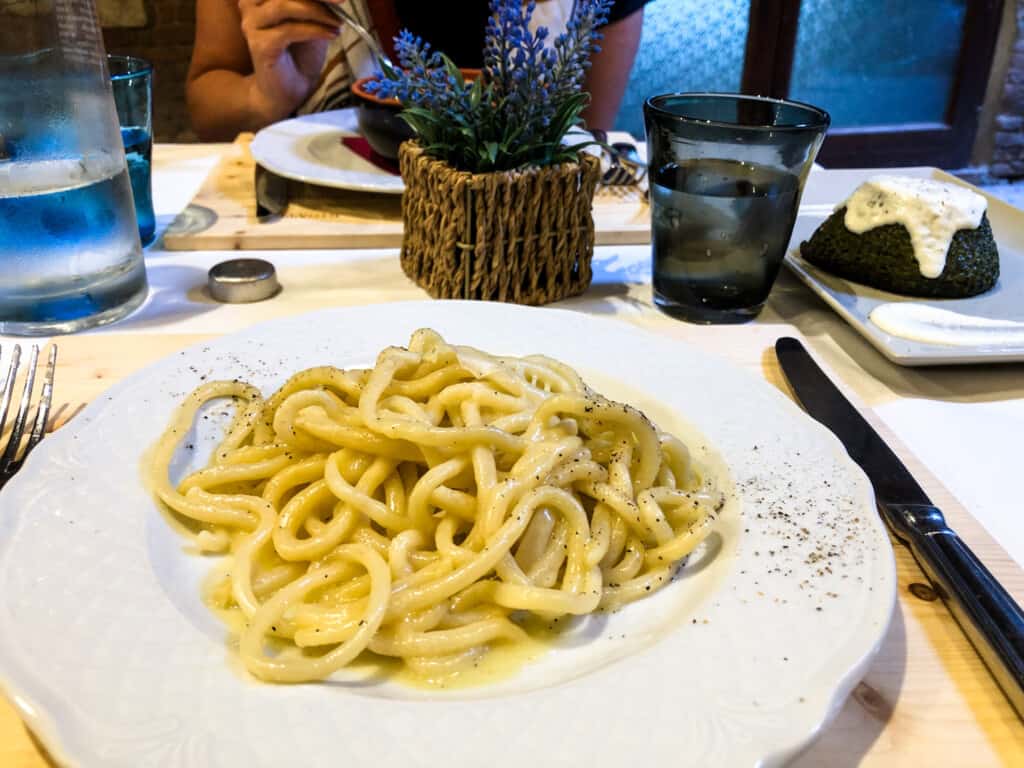Last updated on March 15th, 2024
Did you fall in love with salsa verde toscana (Tuscan green sauce) on your last trip to Italy and looking to recreate it at home?
Tuscan green sauce is a very easy and quick condiment that will add a ton of flavor and zip to any old recipe, Italian or not. Don’t ever be turned off by another plane roasted pork loin because with salsa verde, you can make any simple recipe stand out!
In Tuscany, we add egg and lemon to a basic salsa verde, giving it an extra pop of richness and color.
Salsa verde toscana is one of those Italian recipes that changes from household to household. And today, I am sharing how our family makes it in southern Tuscany.
Use this recipe as a guideline and feel free to experiment with all the added variations that I will include below.
And if you are concerned about how to use it, don’t worry – I have you covered. I’ll show you how to use it on anything from iconic and classic dishes to more inventive and modern plates.
Jump to Section
Salsa Verde Pronunciation
Green sauce in Italian is called salsa verde and is pronounced sahl-sah vehr-deh in Italian.
Listen to the pronunciation of salsa verde:
What is Tuscan Salsa Verde?

Salsa verde is a commonly used condiment made throughout Italy made with parsley, extra virgin olive oil, anchovies, capers and some form of acid.
Like many Italian classics, salsa verde recipes change from region to region and family to family. Many recipes call for a bit of stale bread, pickles, or a hard boiled egg.
The consistency also changes, depending on what it’s being used for. For sandwiches, salsa verde is made a little thicker meanwhile when served with grilled or boiled meats and vegetables, it’s made a bit thinner by adding more olive oil.
Fact: Salsa verde toscana (aka Tuscan salsa verde or Tuscan green sauce) is characterized by the use of lemon and a hard boiled egg. You can also make classic Italian salsa verde.
Making Tuscan Salsa Verde

Making Tuscan salsa verde is very straightforward and everyone has their own personal preferences. Some like it runny and smooth, others prefer it more roughly chopped and ‘pulsed’ together into a paste. There is no rule. You will discover what you like best after various attempts.
Consider this recipe a general guide: check out the variations to get inspiration and add flavor. Master the technique and the habit of keeping a small jar in the refrigerator as Tuscans do and you will be sure never to have a boring meal again!
I prefer it smooth and a bit more liquidy so I can spoon it easily onto my plate if I am serving it grilled fish, meat or vegetables. I like to use an immersion blender and blend everything until it’s super smooth and creamy. In this case, I use more olive oil. Slowly add the oil to allow it to emulsify into the other ingredients to ensure a uniform, smooth sauce.
If I know I am making it for sandwiches or serving it with raw vegetables as a dip, I will add a little less oil and make it more like a mayonnaise consistency so it doesn’t drip out of the bottom of my panino as I dig in.
Salsa Verde Toscana Ingredients

Prep 5 min | Make 5 min | Serves 6
- 3.5 oz (100 grams) flat leaf Italian parsley, cleaned and stalks removed
- 2 anchovy fillets
- 1 garlic clove, peeled
- 1 heaping tablespoon capers, drained and rinsed
- 2 tablespoons lemon juice (between ½ and 1 whole lemon)
- 1 hard boiled egg
- ⅓-½ cup (80-120 ml) extra virgin olive oil.
Choosing An Olive Oil: If you need help buying olive oil, check out 15 Best Italian Olive Oils – To Enjoy in Italy & Bring Home as a Souvenir and Best Italian Olive Oil Brands in America – Where to Buy Them and How to Store Them.
Step-By-Step Instructions for Tuscan Salsa Verde

- Remove the large stalks from the parsley and peel the garlic. Drain and capers and rinse them.
- Blend the parsley, anchovies, garlic, capers, lemon juice, hard boiled egg and a bit of the oil together either with a food processor or with an immersion blender until well combined.
- Slowly drizzle in the remaining extra virgin olive oil while continuing to blend. This is important as it emulsifies the sauce (makes it come together and not separate). Hold back a bit of the olive oil at first and add until desired consistency is achieved.
Note: Add a little less olive oil for a mayonnaise consistency. Add more for a runnier sauce that can easily be spooned onto grilled meats.
Tuscan Salsa Verde Variations
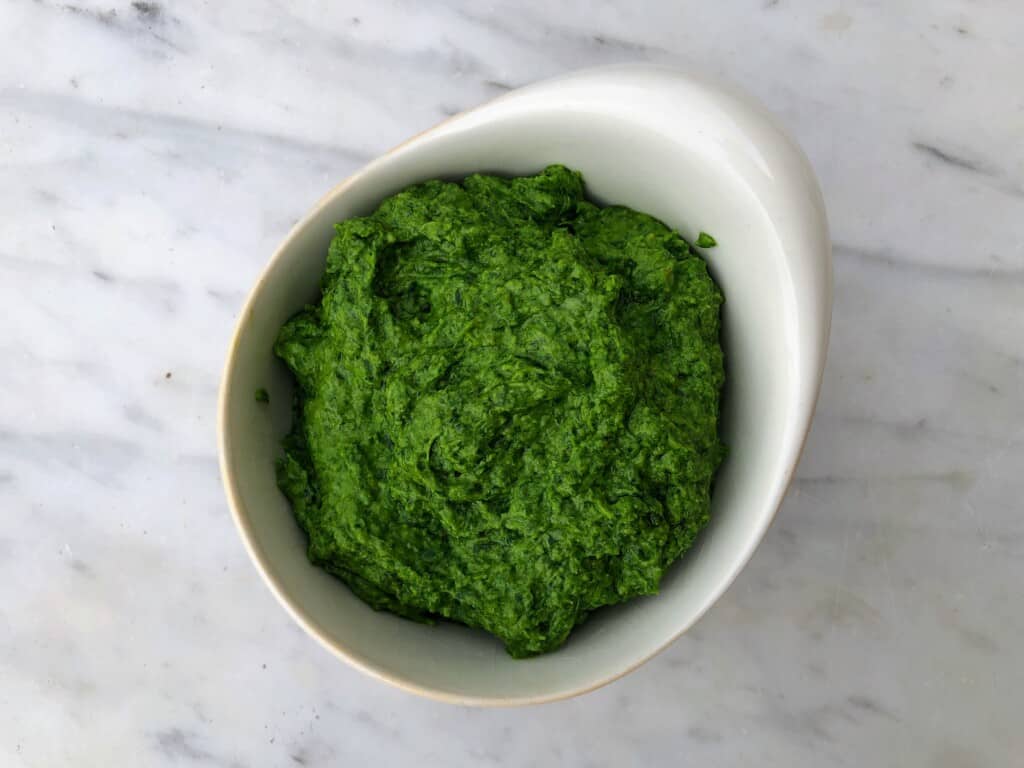
Here are some of the most common variations you will find throughout Italy:
- 30 g stale bread is rehydrated, squeezed dry and added to the mix.
- 8-10 basil leaves are added along with the parsley
- Just the hard boiled yolk is used instead of the whole egg.
- 1 small gherkin pickle can be added with the capers and anchovies
- 2 garlic cloves instead of 1
- 3 anchovy fillets instead of just 2
- zest of 1 lemon
- white vinegar in place of lemon juice
Note: Adding any of these ingredients will change the fluidity of your sauce. Just adjust with more or less olive oil, depending on how thick or runny you prefer your salsa verde.
Serve Salsa Verde Toscana With
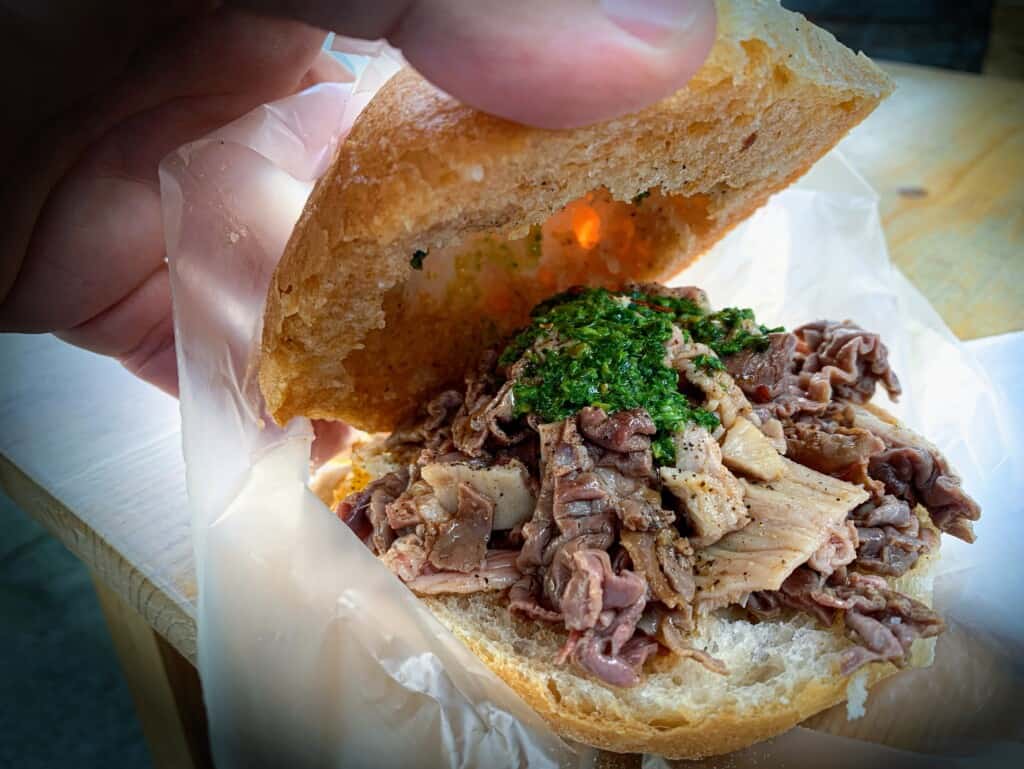
Salsa verde is used throughout the peninsula but here in Tuscany we like to eat it with meat in particular.
Read more about Traditional Tuscan Food.
The rule is simple really: if what is being served can be eaten or jazzed up with a sauce, then add it. Here are some of my favorites:
- Bollito – slow ‘boiled’ beef and vegetables
- Panini – sandwiches
- Panino al lampredotto – lampredotto sandwich (Tuscany)
- Crostini – spread on small rounds of toasted bread
- Grilled vegetables
- Lampredotto – stewed cow’s stomach
- Whole cooked fish or fish filets
- Grilled shrimp, octopus or squid
- Raw vegetables for dipping such as carrots, celery, cucumbers, and artichokes.
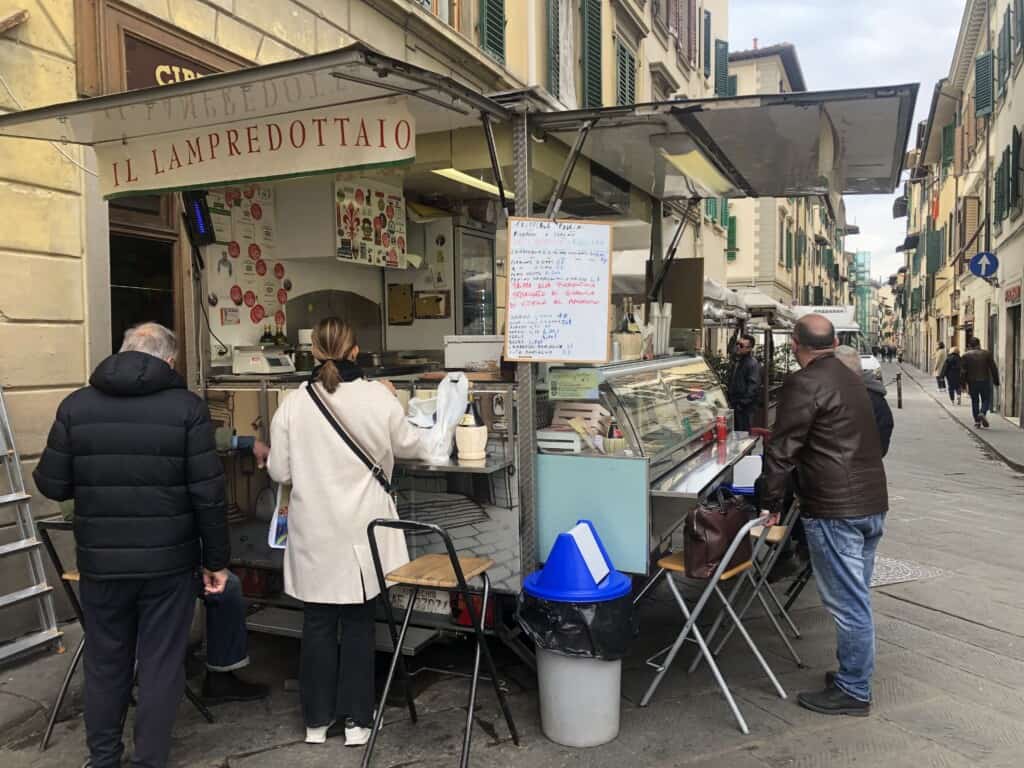
Notes and Tips For Making Tuscan Salsa Verde
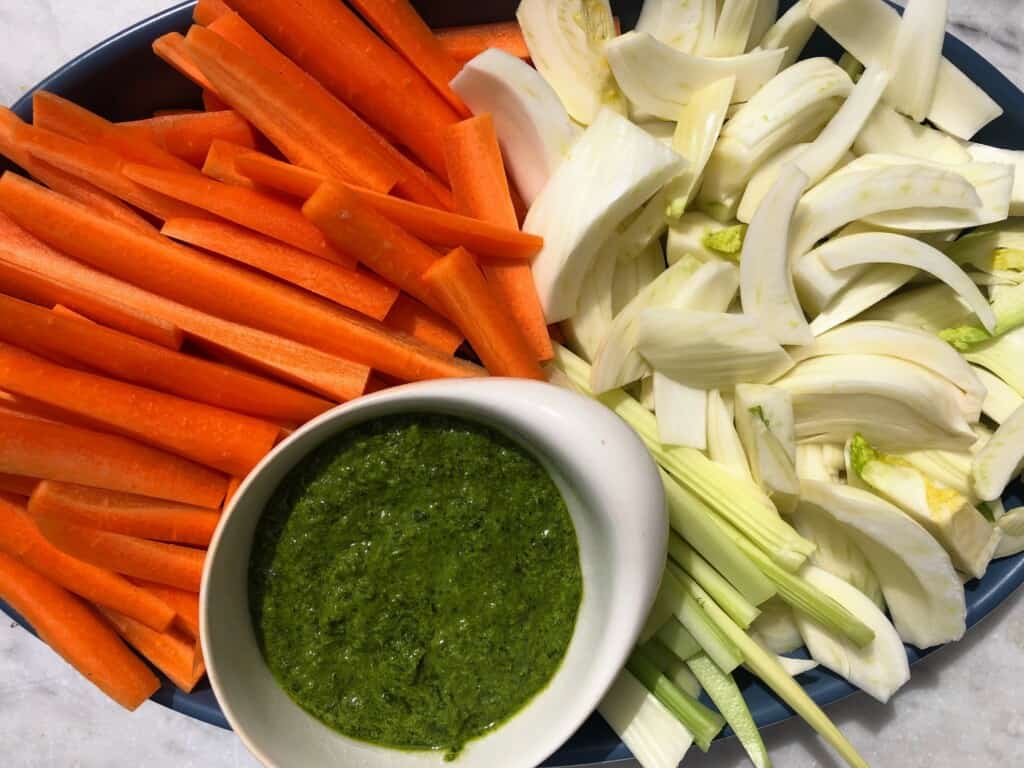
The more you make Tuscan salsa verde, you’ll come to find your ideal consistency. Some people like it a bit more of a paste while others prefer a smoother, runnier sauce. There is no wrong or right: just add more oil for a thinner salsa verde and less for a thicker sauce.
Tuscan salsa verde is a great recipe for using up frozen parsley, making it a great Italian condiment to make and use year round.

Tuscan Salsa Verde
Ingredients
- 3.5 oz flat leaf Italian parsley (100 g), cleaned and stalks removed
- 2 anchovy fillets
- 1 clove garlic
- 1 heaping Tbsp capers drained and rinsed
- 2 Tbsp lemon juice between ½ and 1 whole lemon
- 1 hard boiled egg
- ⅓ – ½ cup extra virgin olive oil (80 – 120 ml)
Instructions
- Remove the large stalks from the parsley and peel the garlic. Drain and capers and rinse them.
- Blend the parsley, anchovies, garlic, capers, lemon juice, hard boiled egg and a bit of the oil together either with a food processor or with an immersion blender until well combined.
- Slowly drizzle in the remaining extra virgin olive oil while continuing to blend. This is important as it emulsifies the sauce (makes it come together and not separate). Hold back a bit of the olive oil at first and add until desired consistency is achieved.
Notes
- Adding any of these ingredients will change the fluidity of your sauce. Just adjust with more or less olive oil, depending on how thick or runny you prefer your salsa verde.
- The more you make salsa verde, the more you will find your ideal consistency. Some people like it a bit more of a paste while others prefer a smoother, runnier sauce. There is no wrong or right: just add more oil for a thinner salsa verde and less for a thicker sauce.
Tuscan Salsa Verde FAQ
Green sauce can be kept in an airtight container with a thin layer of oil on top to prevent it from oxidizing in the fridge for 3 days or in the freezer for 1 month.
Yes, you can freeze it covered with a thin layer of oil in an airtight container for up to 1 month.
Yes, you absolutely can. Just use the best quality that is affordable and accessible to you.
Salsa verde is an Italian condiment made primarily from olive oil, parsley, anchovies, capers and some form of acid. It’s most typically served with cooked meats and fish.
Yes, salsa verde is a condiment made throughout the peninsula, changing slightly from region to region.

